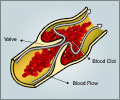An oral drug given after a standard six-month treatment could help prevent future blood clots in patients, according to new research.
Venous thromboembolism (VTE) affects approximately 2 million Americans each year. VTE includes deep vein thrombosis (blood clots common in the thigh and back) and pulmonary embolism (blood clots common in the lung). Despite progress in diagnosis and treatment, VTE is still associated with high morbidity and mortality. While previous studies have shown a risk of recurrence after six months, treatment is often stopped after six months because of the risk of bleeding. A new study examines the use of the oral drug ximelagatran or placebo as a treatment after the six-month standard treatment.The study included 1,233 patients with VTE who had six months of anticoagulant therapy. Half of the patients were then given the drug ximelagatran and the other half was given a placebo for 18 months. Researchers then analyzed how the patients did on the drug compared to those on the placebo.
Researchers report only 12 patients on ximelagatran had a recurrent problem compared with 71 patients on the placebo. They found six patients on the drug died during the 18 months compared with seven patients who died in the placebo group. However, 134 patients on ximelagatran experienced bleeding compared to 111 patients on the placebo. Still, study authors point out that the risk of major hemorrhage was low. Researchers say those patients on ximelagatran had high levels of alanine aminotransferase which is an enzyme present in the liver and heart cells. The levels of this enzyme in patients on the drug were more than three-times the normal level and cause a concern for more research on this treatment, according to study authors.
In conclusion, researchers say the drug ximelagatran is superior to placebo for an extended treatment for VTE. However, they say more research is needed to understand why patients on the treatment had high levels of a certain enzyme.









